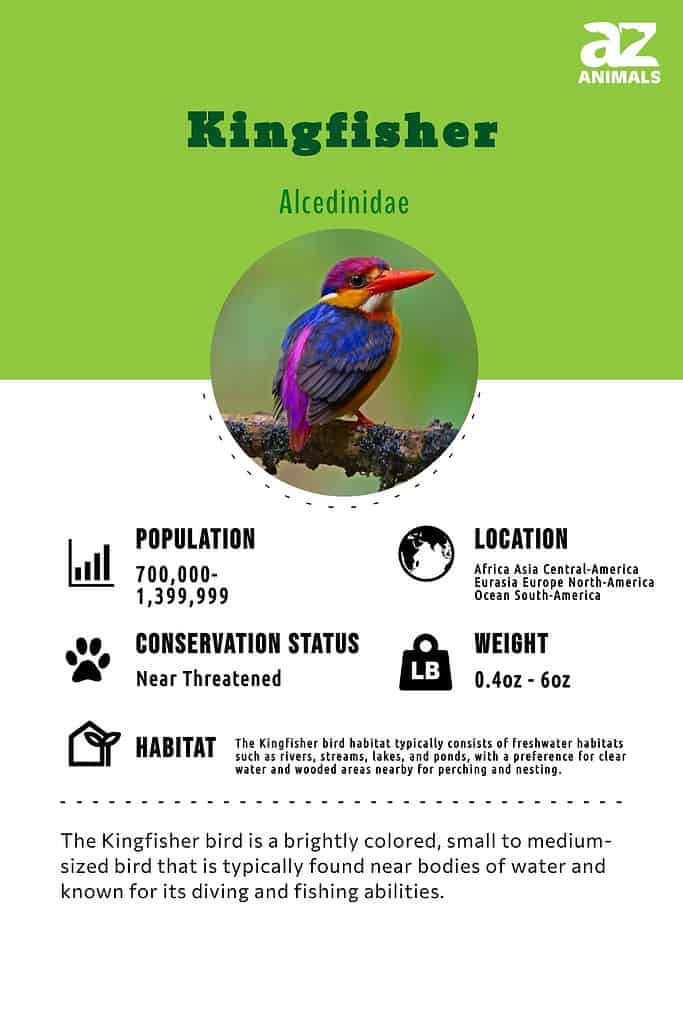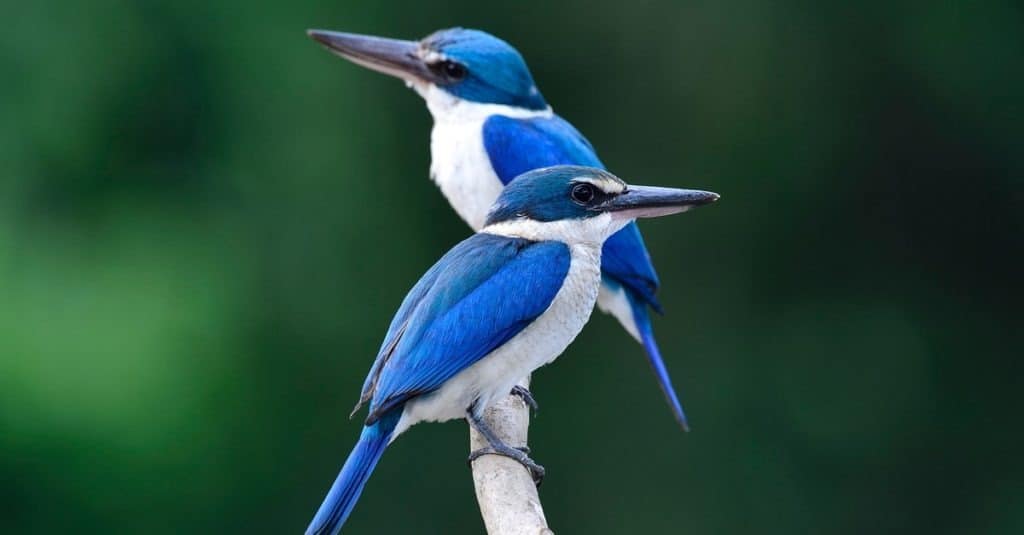Kingfisher
The kingfisher digs burrows into the ground
Advertisement
Kingfisher Scientific Classification
Read our Complete Guide to Classification of Animals.
Kingfisher Conservation Status
Kingfisher Facts
- Main Prey
- Fish, Shrimp, Insects, Tadpoles
- Fun Fact
- The kingfisher digs burrows into the ground
- Distinctive Feature
- Small body and long, sharp and straight beaks
- Wingspan
- Up to 2 feet
- Incubation Period
- 2 to 4 weeks
- Habitat
- Lowland freshwater areas and river estuaries
- Predators
- Foxes, Snakes, Raccoons
- Diet
- Omnivore
- Lifestyle
- Solitary
- Favorite Food
- Fish
- Type
- Bird
- Average Clutch Size
- 4
- Slogan
- Inhabits wetlands and woodlands worldwide!
- Nesting Location
- Burrows
- Age of Molting
- 3 to 8 weeks
- Migratory
- 1
View all of the Kingfisher images!

The kingfisher is a family of brightly colored and unusual-looking birds that live near rivers and bodies of water all over the world.
With their vivid plumage and loud, shrill calls, the kingfisher bird really stands out from the crowd. You can often catch sight of them perched in a tree, barely moving. But upon sighting prey, they spring quickly into action and swoop down to catch it. The amount of variation in the kingfisher family is truly impressive.
3 Amazing Kingfisher Facts

ODKF or Three Toed kingfisher or black-backed kingfisher breeds during monsoons will feed its hatchlings continuously for their growth as metabolism is extremely high.
©iStock.com/lensalot
- The ancient Greeks wove many elaborate myths about the kingfisher bird. One of the most well-known is the myth of the “halcyon days,” which refers to the calm period of light weather on the winter solstice. The Greeks believed that the god of winds calmed the weather so that a kingfisher called Halcyon could lay her eggs in peace. The source of this myth is unclear since the kingfisher doesn’t actually breed in the winter.
- Kingfisher birds have very strong legs since they spend the vast majority of their time perched within trees.
- The kingfisher’s eggs are colored almost pure white.
Evolution and Origins
The earliest fossilized kingfishers have been discovered in Lower Eocene sediments, which are quite recent and date to roughly 40 million years ago. These Wyoming deposits are complemented by even more recent deposits from Germany and France as well as by Australian material that is younger than 25 million years.
Due to a modification in their lenses, they are able to accurately determine the depth of their prey even when they are underwater. As it dives in, a piece of membrane slides over its eyes to block the water from getting in. The nictitating membrane is the name of it.
Science discovered that the cyan and blue barbs of its feathers had spongy nanostructures of various sizes, which alter how light reflects and result in the colors that are seen. Little changes in the barbs’ structural makeup cause minor variances within colors.
Where to Find the Kingfisher

Alcedo atthis
These birds are found in almost every region of the world except for the most extreme polar and desert climates. The greatest concentration seems to occur in tropical regions such as Africa, South Asia, Australia, and the rest of the Pacific. Most species live near rivers and lakes.
Nests
The kingfisher has the habit (which is very unusual for birds) of digging burrows into banks, tree cavities, or termite mounds. After about a week of digging out dirt with their feet, the parents will have created a burrow about 3 to 6.5 feet long with a nesting chamber at the end.
Scientific Name

©Anusak Thuwangkawat/Shutterstock.com
The scientific name for the kingfisher family is Alcedinidae. This scientific name derives from the Latin name for the bird, alcedo. There are some 90 species currently recognized, each one classified into three distinct types: the true fishing kingfishers, the forest kingfishers, and the New World kingfishers. The entire kingfisher family is closely related to the bee-eaters, rollers, and motmots in the order of Coraciiformes.
Different Types
Here are the 13 different types of Kingfisher Birds:
- Belted Kingfisher
- Tree Kingfisher
- Common Kingfisher
- Collared Kingfisher
- Green Kingfisher
- Giant Kingfisher
- Malachite Kingfisher
- Amazon Kingfisher
- Woodland Kingfisher
- Crested Kingfisher
- Pied Kingfisher
- Sacred Kingfisher
- Ringed Kingfisher
Size, Appearance & Behavior
The kingfisher looks like it was strangely put together in a lab. It has a relatively large head, thick feet, and a dagger-like bill attached to a rather small, compact body and stubby tail. The smallest species is the 4-inch long African dwarf kingfisher, while the largest species are the giant kingfisher and laughing kookaburra with a 2-foot wingspan and 18-inch body. The plumage is usually some combination of bright blue, green, orange, or red with all manner of different patterns and stripes adorning it. Some species also sport a prominent crest on the head.
These birds prefer small social organizations that consist of mating pairs or families. It relies on a suite of different vocalizations (including clicks, whistles, screams, and chirps) to communicate with each other. The laughing kookaburra, which is native to Australia, has the most mirthful sound of all species. As the name suggests, this call resembles a loud laugh. The kingfisher also invests a great deal of time into remaining clean. It will dive into the water to wash off and rub its bill against a branch to keep it in pristine condition.
Pattern and Timing
These birds, as a general rule, rarely stray far from their home territory. The home range is so important to them that they will aggressively defend their territory from intruders. Only a few types of kingfishers break this rule. For instance, the belted kingfisher is a long-range migratory species. It breeds as far north as Alaska and Canada and travels as far south as Mexico and Central America in the winter. The belted kingfisher also occupies the continental United States all year round.
Diet
Although this bird is omnivorous, they seem to be adapted most of all for hunting and consuming meat. Its favorite hunting strategy is to observe the environment around it from a stalk or tree branch and then swoop down on unsuspecting prey. If the prey is still alive and squirming, then the kingfisher may beat it against the perch to subdue it. With its voracious appetite, the kingfisher has the ability to digest prey even bigger than its entire body. The prey will sometimes stick out of the mouths as part of it is being digested in the stomach.
What does the kingfisher eat?
Despite the name, most types do not specialize in fish alone. They are highly opportunistic hunters that will consume insects, snakes, skinks, spiders, crabs, mice, scorpions, berries, and even smaller birds. The exact diet depends on the local availability of food.
Predators and Threats
These birds face a few threats in the wild from natural predators, habitat loss, and introduced non-native predators.
What eats the kingfisher?
An adult bird has only a few natural predators in the wild. It can evade most animals by flying around trees or diving into the water. Only birds of prey are usually fast and agile enough to keep up with it in the air. Raccoons, skunks, dingoes, foxes, snakes, mongooses, and chimpanzees are all known predators of the far more vulnerable kingfisher eggs.
Reproduction, Babies, and Lifespan
These bird mating seasons can take place at any time of the year (but spring and summer are more common for temperate kingfisher species). Courtship involves an elaborate process of aerial chases, mutual feeding, and attention-getting displays of affection.
This helps to strengthen their bond because once they find a mate, these birds will often pair for life. After the mates copulate, the female will lay one egg per day until she’s produced between two and 10 eggs in the nest. Couples can produce up to four broods in a single year, depending on favorable conditions.
Because the young chicks emerge from the eggs blind and helpless, the parents invariably play a significant role in the development of their offspring. Older children of the laughing and blue-winged kookaburra species may also help their parents with caretaking duties.
After three to eight weeks, the chicks will finally grow their flight feathers. They do not have long to learn the nuances of flight before the parents will eventually force the chicks to leave the nest. Depending on the species, the life expectancy is some six to 14 years in the wild.
Population
The kingfisher family, as a whole, is in excellent health. Most species are generally regarded by conservation organizations to be least concern. The common kingfisher is perhaps the most widespread species with some 700,000 to 1.4 million mature individuals in the wild.
The giant and belted kingfisher are also quite robust. However, some of the rarest kingfishers in the world, including the Marquesas kingfisher and the Tuamotu kingfisher, both of which inhabit small Pacific Islands, are critically endangered. The Micronesian kingfisher, in the worst shape of all, is completely extinct in the wild. Only about 150 individuals exist in captivity, some of which are kept at the San Diego Zoo.
View all 77 animals that start with KKingfisher FAQs (Frequently Asked Questions)
Does the kingfisher migrate?
Only a few species of kingfisher are actually migratory. The rest fiercely guard their home territory throughout the entire year.
How many eggs does the kingfisher lay?
The kingfisher lays anywhere between two and 10 eggs per brood with up to four broods per year.
How fast does the kingfisher fly?
The kingfisher has a top speed of some 25 mph.
What is the kingfisher’s wingspan?
The kingfisher has a wingspan stretching between a few inches and about 2 feet long. The typical species has a wingspan of around a foot.
When do kingfisher chicks leave the nest?
The kingfisher chicks usually leave the nest within a few months of hatching. However, some species are very family-oriented. They allow the offspring to stick around in the nest to help raise the next brood.
What does a kingfisher look like?
The kingfisher is easy to identify from its disproportionate appearance. It has a small body and tail combined with a relatively giant head, strong feet, and long, narrow bill. Each species has its own set of colors and patterns.
What does a kingfisher eat?
Fishing is the stock and trade of many kingfisher species. But they will eat almost anything, including insects, arthropods, reptiles, small mammals, and other birds.
Where does the kingfisher live?
The kingfisher lives in forests and grasslands right next to rivers and lakes.
Are kingfisher birds rare?
Kingfishers are some of the most common birds around the world.
What do kingfisher birds sound like?
The kingfisher’s calls consist of whistles, chirps, shrieks, screams, clicks, and even a laughing sound. These sounds are not organized into songs, but they each seem to serve a distinctive purpose to communicate with others.
Are Kingfishers herbivores, carnivores, or omnivores?
Kingfishers are Omnivores, meaning they eat both plants and other animals.
What Kingdom do Kingfishers belong to?
Kingfishers belong to the Kingdom Animalia.
What class do Kingfishers belong to?
Kingfishers belong to the class Aves.
What phylum to Kingfishers belong to?
Kingfishers belong to the phylum Chordata.
What family do Kingfishers belong to?
Kingfishers belong to the family Alcedines.
What order do Kingfishers belong to?
Kingfishers belong to the order Coraciiformes.
What type of covering do Kingfishers have?
Kingfishers are covered in Feathers.
What are some predators of Kingfishers?
Predators of Kingfishers include foxes, snakes, and raccoons.
What are some distinguishing features of Kingfishers?
Kingfishers have small bodies and long, sharp, and straight beaks.
What is an interesting fact about Kingfishers?
Kingfishers inhabit wetlands and woodlands worldwide!
What is the lifespan of a Kingfisher?
Kingfishers can live for 6 to 10 years.
How do Kingfishers have babies?
Kingfishers lay eggs.
Thank you for reading! Have some feedback for us? Contact the AZ Animals editorial team.
Sources
- Animal Diversity Web, Available here: https://animaldiversity.org/accounts/Alcedinidae/
- San Diego Zoo, Available here: https://animals.sandiegozoo.org/animals/kingfisher

















